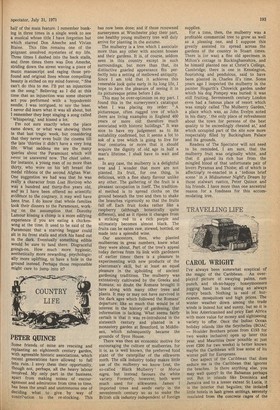COUNTRY LIFE
PETER QUINCE
Some friends of mine are rescuing and replanting an eighteenth century garden, With agreeable historic associations, which recent generations have allowed to fail into ruin. I envy them their opportunity, though not, perhaps, all the heavy labour Involved. My only part in the business, apart from making noises of encouragement and admiration from time to time, has been the small and unstrenuous one of deciding what to give by way of contrillution to the re-stocking. This has now been done; and if those renowned nurserymen at Winchester play their part, one healthy young mulberry tree will duly arrive for planting in the autumn.
The mulberry is a tree which I associate more than any other with ancient houses and their gardens. It is, of course, seldom seen in this country except in such surroundings; but more than that, its distinctive gnarled appearance fits perfectly into a setting of mellowed antiquity. Since I am told that it achieves this venerable look quite early in its long life, I hope to have the pleasure of seeing it in its picturesque prime before I die.
This may be over-optimism on my part. I found this in the nurserymen's catalogue when I was placing my order: "A picturesque, often rugged tree of which there are living examples in England 400 years or more old: therefore much associated with historic buildings." It was nice to have my judgement as to its suitability confirmed, but it seems a lot to ask of a tree which is going to live for four centuries or more that it should acquire the dignity of old age in half a man's lifetime. I shall have to wait and see.
In any case, the mulberry is a delightful tree and I wonder that more are not planted. Its fruit, for one thing, is delicious, with a fine sharp flavour unlike any other. The gathering of the fruit is a pleasant occupation in itself. The traditional method is to spread cloths on the ground beneath the tree and then to shake the branches vigorously so that the fruits fall off. Each fruit looks rather like a raspberry (although botanically quite different), and as it ripens it changes from a striking red to a rich purple and ultimately becomes almost black. The fruits can be eaten raw, stewed, bottled, or made into a splendid wine.
Our ancestors, then, who planted mulberries in great numbers, knew what they were about. Part of the tree's appeal today derives from its link with gardeners of earlier times: there is a pleasure in experimenting with new products of the plantsman's skill, but at least an equal pleasure in the upholding of ancient gardening traditions. The mulberry was extensively cultivated by the Greeks and Romans; no doubt the Romans brought it here along with many other trees and plants. It may or may not have survived in the dark ages which followed the Romans' departure: like so much that would be of interest in the history of gardening, that information is lacking. What seems fairly certain is that it was re-introduced in the sixteenth century and planted in a monastery garden at Brentford, in Middlesex, which subsequently became the grounds of Syon House.
There was then an economic motive for encouraging the culture of mulberries, for it is, as is well known, the preferred food plant of the caterpillar of the silkworm moth. The silk industry today makes little use of the mulberry we know test, the so-called Black Mulberry' or Morus nigra, but instead favours the white variety. Formerly, however, both were much used for silkworms. James I imported trees and seeds early in the seventeenth century so as to make the British silk industry independent of foreign
For a time, then, the mulberry was a profitable commercial tree to grow, as well as a pleasing one, and I suppose this greatly assisted its spread across the gardens of the country in Stuart times. There is (or was) a fine old specimen in Milton's cottage in Buckinghamshire, and he himself planted one at Christ's College, Cambridge; there is one in Kensington, flourishing and pendulous, said to have been planted in Charles ll's time. Some years ago I inspected the mulberry in the painter Hogarth's Chiswick garden under which his dog Pompey was buried: it was still fruiting. Seventeenth century London even had a famous place of resort which was simply called The Mulberry Garden,' a place which was, as John Evelyn noted in his diary, 'the only place of refreshment about the town for persons of the best quality to be exceedingly cheated at,' and which occupied part of the site now more respectably filled by Buckingham Palace and its grounds.
Readers of The Spectator will not need to be reminded, I am sure, that the mulberry fruit was originally white, and that it gained its rich hue from the mingled blood of that unfortunate pair of lovers Pyramus and Thisbe; all of which is affectingly re-enacted in a 'tedious brief scene' in A Midsummer Night's Dream by those stalwart rustics, Peter Quince and his friends. I have more than one ancestral reason for a fondness for this accommodating tree.










































 Previous page
Previous page